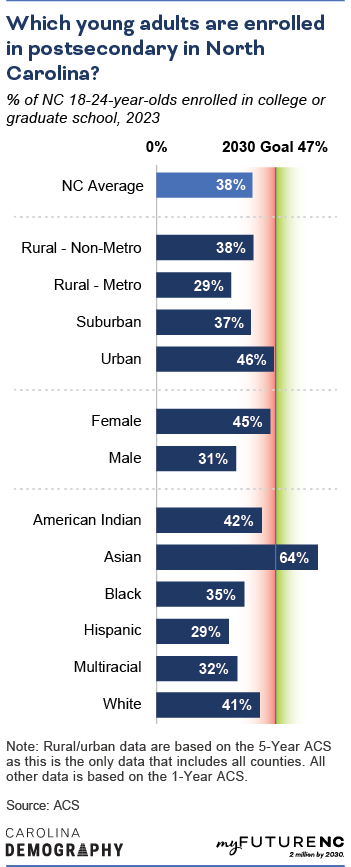Percentage of North Carolinians aged 18-24 enrolled in a postsecondary institution
Data year: 2023
= Top southern state :
only available for totals, not available for all indicators
What does Postsecondary Enrollment Rate mean?
Percent of 18-24-year-olds enrolled in college or graduate school.
What does this data show?
North Carolina’s postsecondary enrollment rate is 38%, placing our state 27th among all states in 2023. In Virginia, the southern state with the highest postsecondary enrollment rate, 42% of 18-24-year-olds are enrolled in college or graduate school. Nationally, Rhode Island had the highest postsecondary enrollment rate in 2023 (54%).
By 2030, the goal is to have 47% of North Carolina 18-24-year-olds enrolled in college or graduate school. This goal was set by the myFutureNC Commission.
Why does Postsecondary Enrollment Rate matter?
Postsecondary enrollment and postsecondary attainment are tightly linked: enrollment in postsecondary is a necessary precursor to earning a degree or credential.
This indicator measures postsecondary participation rates of typical college-age (18-24) residents. At the state level, higher participation rates indicate that the state is serving more young adults in postsecondary education. It also may mean that high school students in the state are better prepared for the transition to postsecondary.
How is North Carolina performing?
Meeting the 2030 Goal
North Carolina needs 92,892 more 18-24-year-olds enrolled in college or graduate school to meet the statewide postsecondary enrollment goal.
 In 2006, North Carolina’s postsecondary enrollment rate was 38%, ranking 29th among the states. In 2023 the state’s postsecondary enrollment rate was back at the 2006 level (38%) and the state was ranked 27th.
In 2006, North Carolina’s postsecondary enrollment rate was 38%, ranking 29th among the states. In 2023 the state’s postsecondary enrollment rate was back at the 2006 level (38%) and the state was ranked 27th.
Trends
The postsecondary enrollment rate increased during the Great Recession, rising from 38% in 2006 to a high of 42% in 2011. National rates followed a similar pattern, rising from 40% in 2006 to a high of 43% in 2011.
During this period, North Carolina’s postsecondary enrollment rate was persistently lower than the national average. The decline in the enrollment rate during the economic recovery has been more pronounced in North Carolina than the national trend, though in 2023 North Carolina’s postsecondary enrollment rate was only slightly lower than the national average (38% versus 40% nationally).
By geography
 Urban North Carolina counties had the highest postsecondary enrollment rates in 2023 (46%). Non-metropolitan rural counties had the second highest enrollment rates in 2023 (38%), closely followed by suburban counties (37%). Postsecondary enrollment rates were lowest in rural counties within a metropolitan area (29%). At the county level, postsecondary enrollment is strongly associated with the presence of a college or university.
Urban North Carolina counties had the highest postsecondary enrollment rates in 2023 (46%). Non-metropolitan rural counties had the second highest enrollment rates in 2023 (38%), closely followed by suburban counties (37%). Postsecondary enrollment rates were lowest in rural counties within a metropolitan area (29%). At the county level, postsecondary enrollment is strongly associated with the presence of a college or university.
By sex
North Carolina women ages 18-24 are more likely to be enrolled in a postsecondary institution than North Carolina men (45% vs. 31%).
By race/ethnicity
Asian young adults are most likely to be enrolled in a college or graduate program (64%) and were the only group where more than half of 18-24-year-olds were enrolled in postsecondary. American Indian adults were enrolled at the next highest rate (42%), followed by White adults (41%). Thirty-five percent of Black young adults were enrolled in postsecondary education followed by Multiracial (32%), and Hispanic (29%) young adults had the lowest postsecondary enrollment rates in 2023.
Methodology
Where does the data for the postsecondary enrollment rate come from?
The U.S. Census Bureau’s American Community Survey (ACS). This annual survey of demographic, economic, and social characteristics has been collected for all households and group quarters populations since 2006. The Public Use Microdata Series (PUMS) contains anonymized person-level observations that enable custom tabulations of the data for the state and some counties. Data for all counties is available in the 5-Year ACS in Table B14004: Sex by College or Graduate School Enrollment by Type of School by Age for the Population 15 Years and Over.
How was the data calculated?
Carolina Demography calculated the statewide postsecondary enrollment rate using ACS PUMS data retrieved from IPUMS-USA. Individuals were identified as being enrolled in college or graduate school if they reported being enrolled in school and specified one of the following enrollments during the last three months:
- “College undergraduate years (freshman to senior)”
- “Graduate or professional school beyond a bachelor’s degree (for example: MA or PhD program, or medical or law school)”
The postsecondary enrollment rate was calculated by dividing the estimated number of adults ages 18-24 enrolled in college or graduate school by the total number of adults 18-24.

Who is included?
All residents of North Carolina ages 18-24.
Who isn’t included?
Certain types of group quarters facilities are not sampled due to difficulties associated with data collection, such as domestic violence shelters, soup kitchens, and living quarters for victims of natural disasters. Full details on the ACS sample and methodology are available here.
The data used in the development of this indicator is derived from a survey and is subject to sampling and non-sampling error.
Learn more
Who is working on this in NC?
Help improve this section
If you know of an organization that is working on this topic in NC, please let us know on the feedback form.
Name: College Advising Corps
Scope: Partnership at universities throughout North Carolina
Website: https://www.cfnc.org/fafsaday
About:
College Advising Corps focuses on college enrollment and completion among low-income, first-generation college, and underrepresented high school students by delivering personalized, knowledgeable guidance on college admission, financial aid, and enrollment.
Name: Gear Up North Carolina
Scope: National
Website: https://www.northcarolina.edu/gearup
About: GEAR UP NC partners with the College Foundation of North Carolina, ACT Inc., the North Carolina Department of Public Instruction, and the State Education Assistance Authority for statewide dissemination of college information. GEAR UP NC is included in the University of North Carolina System Higher Expectations Strategic Plan as a strategy for promoting and improving access to higher education in North Carolina.
Name: College Foundation of North Carolina
Scope: Statewide
Website: https://www.cfnc.org/
About: College Foundation of North Carolina (CFNC) is a free service of the State of North Carolina provided by a collaboration of Pathways (the NC Department of Public Instruction, the NC Community College System, the NC Independent Colleges and Universities, and The University of North Carolina System), the North Carolina State Education Assistance Authority, and College Foundation, Inc. CFNC promotes access to North Carolina higher education and assists students with education planning, career planning, and applying to and paying for college.
Further research and literature
Castleman, B. L., & Page, L. C. (2014). A Trickle or a Torrent? Understanding the Extent of Summer “Melt” Among College-Intending High School Graduates. Social Science Quarterly, 95(1), 202–220.
Horn, L., Cataldi, E. F., & Sikora, A. (2005). Waiting to Attend College: Undergraduates Who Delay Their Postsecondary Enrollment (NCES 2005-152). Washington, D.C.: U.S. Department of Education.
Niu, S., & Tienda, M. (2013). Delayed enrollment and College Plans: Is There a Postponement Penalty? The Journal of Higher Education, 84(1), 1–26.
Tippett, R., & Kahn, N. (2018a). Postsecondary Pathways & Barriers to Opportunity Report: 2009-2011 NC Public High School Graduates. Raleigh, NC: myFutureNC.
Tippett, R., & Kahn, N. (2018b). Postsecondary Enrollments Report: 2009-2016 North Carolina Public High School Graduates. Raleigh, NC: myFutureNC.
FAQ
Does the indicator reflect full-time or part-time enrollment?
The postsecondary enrollment rate includes all enrollments, both full-time and part-time.



